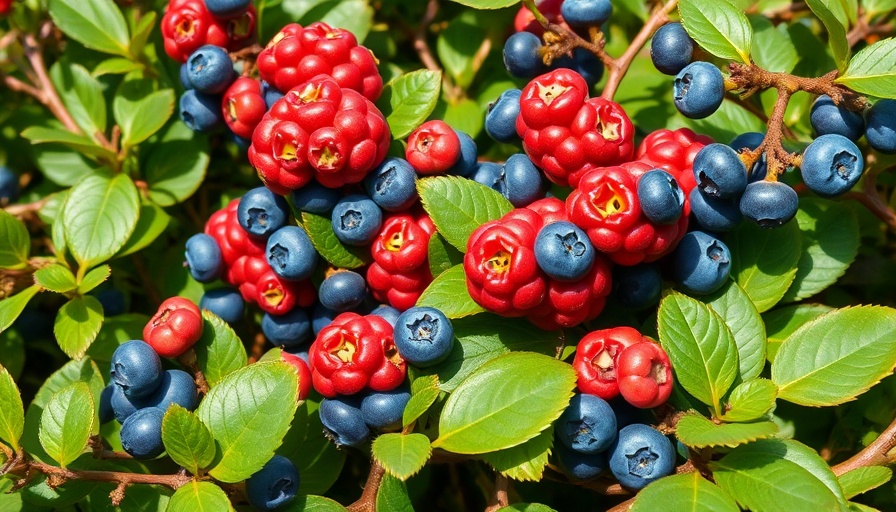
The Sweetly Tangy Delight of Honeyberries
Haskap, known commonly as honeyberry, is more than just a mouthful of a name; it's a truly delectable fruit that combines the flavors of blueberries, raspberries, and black currants. This cold-hardy shrub (Lonicera caerulea) thrives in regions where most fruits cannot bear the chill, making it the perfect addition for gardeners in USDA Hardiness Zones 2 to 8. With proper nurturing, these bushes promise not just a bountiful fruit supply but also a burst of flavor every early summer.
Planting Your Honeyberry: Getting Started
To start your honeyberry journey, pick a sunny spot in your garden that receives at least four to six hours of sunlight daily. Haskap prefers well-draining, sandy or loamy soil with a pH lying between 5.5 and 8.0. It’s essential to prepare the site thoroughly before planting, as these plants will thrive if given the right start. Early spring, after the last frost, is the ideal time to plant, allowing the shrubs to establish their roots before the summer heat sets in.
Selecting the Right Cultivars
Choosing the appropriate variety of honeyberry is crucial for success and flavor. Russian cultivars often excel in cooler climates while Japanese types prefer warmer summers. Popular options you might consider include ‘Blue Moon,’ which is known for its resilient nature and productivity and ‘Honeybee,’ which produces sweet fruits early in the season. By selecting the right type tailored to your climate, you can ensure fruitful harvests for years to come.
The Art and Science of Pollination
Though honeyberries are self-pollinating, they flourish best when planted alongside other varieties. Having multiple cultivars ensures cross-pollination, leading to enhanced fruit set and a richer harvest. Not only does this increase your yield, but it also encourages a vibrant garden ecosystem, attracting bees and other beneficial insects that further bolster your garden's health.
Pest Control and Disease Management
While honeyberries are relatively pest-resistant, they are not completely immune. Common pests include aphids and spider mites. Cultivating companion plants such as marigolds can help repel unwanted insects naturally. It’s also essential to monitor for any signs of disease, including powdery mildew, which can be managed with proper spacing and airflow around the plants.
Harvesting: When and How
Your first crop may come as soon as year three, with full yields typically reached by year four or five. The secret to ripe honeyberries lies in the color; wait for that stunning deep blue hue before enjoying them fresh or preserving them. Harvest them early in the morning when temperatures are cooler for the best flavor and texture.
Preserving Your Honeyberry Harvest
Once you have a bountiful harvest, consider turning your honeyberries into jams, jellies, or even wines. Their tangy flavor shines in desserts, too, so don’t hesitate to explore various recipes that incorporate these nutrient-rich berries. If you have excess fruits, freezing them helps to retain their flavor and nutrition for later use in smoothies, baking, or breakfast cereals.
Embracing Honeyberries for a Sustainable Future
Integrating honeyberries into your home garden not only enriches your diet with healthy, organic produce but also fosters greater biodiversity in your local ecosystem. The journey of growing haskaps is about more than just enjoying their sweet-tart contributions; it’s an empowering leap toward a more self-sufficient lifestyle.
As a DIY enthusiast, starting with a few honeyberry plants opens the door to a world of gardening adventures. You can elevate your gardening game by experimenting with various propagation techniques or creating unique recipes to delight your friends and family.
Call to Action: Join the Honeyberry Movement Today!
If you're looking to improve your gardening skills or want to dive into a sustainable source of delicious fruit, planting honeyberries is a rewarding project. Whether you're an urban dweller or a suburban homeowner, this hardy shrub will adapt and flourish in your space. Learn more about the sheer joys of growing honeyberries and discover the many ways they can enrich your life and garden.
 Add Row
Add Row  Add
Add 




 Add Row
Add Row  Add
Add 

Write A Comment